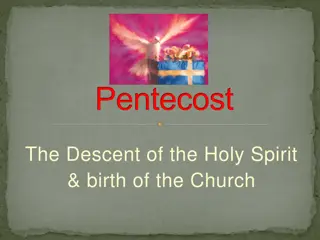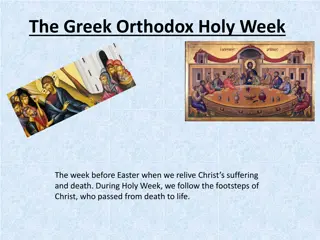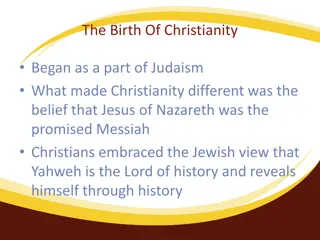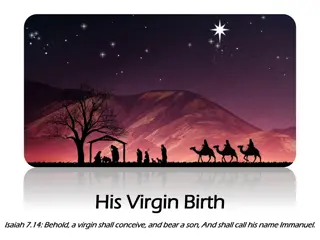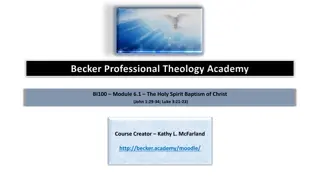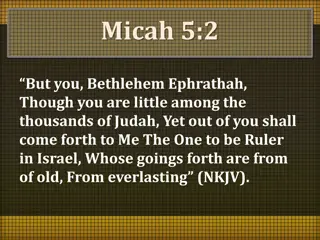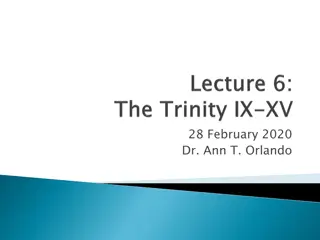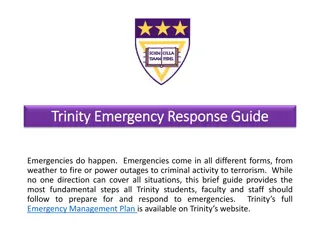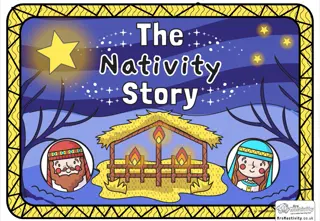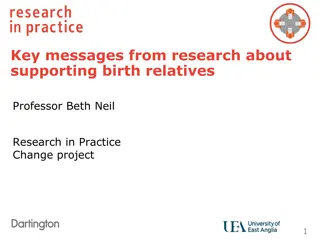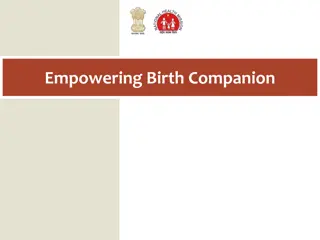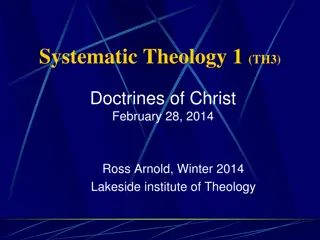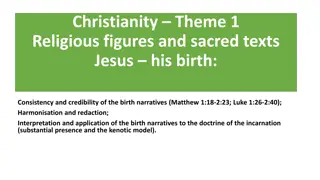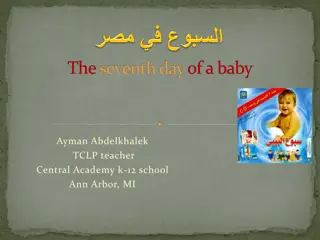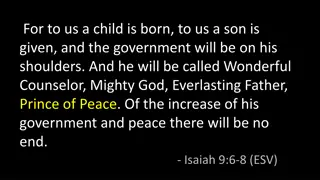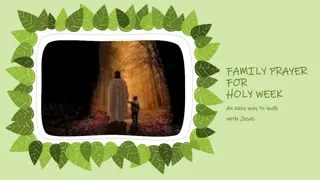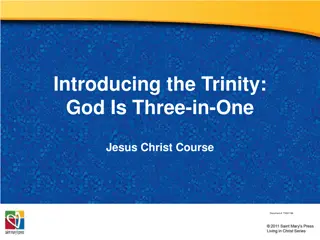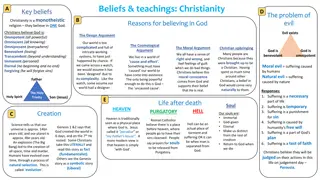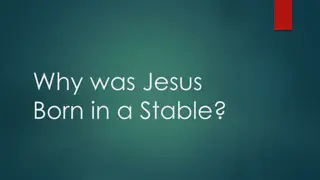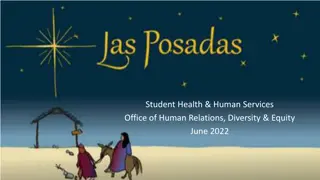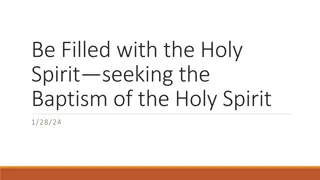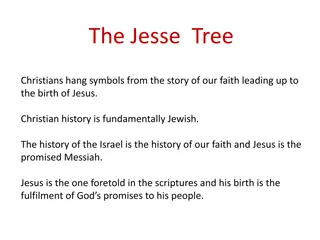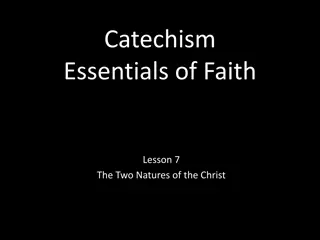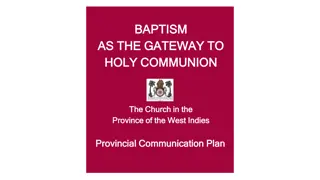Insights on the Holy Trinity, Historical Locations, and Celebration of Jesus' Birth
Discover the significance of the Holy Trinity, explore historical locations like Judea and Galilee, and learn about the evolution of the celebration of Jesus' birth. Uncover details about the rulers of different regions during biblical times and the early practices of Christianity.
Download Presentation

Please find below an Image/Link to download the presentation.
The content on the website is provided AS IS for your information and personal use only. It may not be sold, licensed, or shared on other websites without obtaining consent from the author. Download presentation by click this link. If you encounter any issues during the download, it is possible that the publisher has removed the file from their server.
E N D
Presentation Transcript
The Holy Trinity The Holy Trinity One God in three persons One God in three persons Triune: Tri means 3 Unity means 1 Triune: Tri means 3 Unity means 1 Attributes of God: Is a Spirit Is Infinite (no end) Is Eternal (from beginning) Omniscient Omnipotent Omnipresent Persons of God: Father Son (Became Jesus in the flesh) Holy Spirit Correct application of math: 1x1x1=1 Incorrect application of math: 1+1+1=3 Deuteronomy 6:4 Genesis 2:24
SAMARIA & JUDEA : Herod Archaleus (Ethnarch- Senior Ruler) GALILEE: Herod Antipas (Tetrarch of Kingdom). Married Herodias former wife of his brother Philip I . Also beheaded John the Baptist for denouncing his marriage. GAULANTIS & PERAEA: Herod Philip II (Tetrarch) DECAPOLIS : Autonomous 10 cities (no King) that pledged their allegiance to Roman government and paid tribute to Rome. Where was Jesus Baptized (John 1:26-28)? Bethany (Beyond the Jordan) Where were the disciples Phillip, Andrew and Peter from (John 1:44) Bethsaida What area was John the Baptist born and what areas did he go preach and baptize (Luke 1:8-8; Luke 1: 39- 40; Luke 3:1-3) Hill Country of Judea near Jerusalem All the areas around the Jordan River
* II * - part of the Maccabean (Hasmonian) Dynasty
Celebration of The Birth of Jesus For the first three centuries of Christianity s existence, the birth of Jesus Christ was not celebrated at all. The most significant holidays were a) Epiphany commemorating the arrival of the Magi after his birth and b) Easter celebrating the resurrection The first official mention of December 25th appeared in an early Roman calendar from 336 A.D. Church officials settled on the date of December 25th at the end of the third century. It appears they wanted to date to coincide with existing pagan festivals honoring Saturn (Roman god of agriculture) and Mithra (Persian god of light). This would have made it easier to convince Rome s pagan subjects to accept Christianity as the empires official religion.
Average Temperatures in Jerusalem Two clues the Bible gives us about the birth of Jesus: 1. Shepherds had their flocks out in the fields 2. The Roman Governor instituted a Census requiring people to travel to their home province Would these be more likely in the Winter or Spring? Why did the Angels appear to the Shepherds? Possibly because they were in the fields awaiting the birth of their lambs.
Interesting Sheep / Lamb Facts: Sheep have their lambs in late winter or early spring as they also need to eat lots of fresh grass so that they can make milk for their lambs. Lambing. Lambs are born around 145 days (or about 4.5 months) after the ewe falls pregnant. Lambing can start as early as December and go on to as late as June. Spring lambing coincides with the natural breeding and lambing seasons. Withspring lambing, breeding and lambing periods tend to be more condensed, because ewes and rams are most fertile during a fall mating season. March and April are peak lambing time in the UK, although the main season runs from February to April and some farmers even lamb before Christmas.
Months of the Hebrew Ecclesiastical Calendar Exodus 12:2; 13:3-4 Esther 3:7 The first month was originally called Abib but later changed to Nisan after the captivity
Relationship of the Tabernacle to Jesus What did the Tabernacle (tent of meeting) symbolize? It symbolized the presence of God with his people. God instructed Moses that the sanctuary was to be set up on the first day of the first month of the 2nd year after leaving Egypt (Exodus 40:2, 17). Doing a little bit of math we can conclude that the building of the sanctuary took less than nine months the command to build it was given in the third month and the erection was in the first month of the 2nd year, therefore 12 3 = 9. What is significant about 9 months as it pertains to the birth of Jesus? (Immanuel = God with us ) Some believe Jesus was conceived in December but born in March or April (first day of first month).
SAMARIA & JUDEA : Herod Archaleus (Ethnarch- Senior Ruler) GALILEE: Herod Antipas (Tetrarch of Kingdom). Married Herodias former wife of his brother Philip I . Also beheaded John the Baptist for denouncing his marriage. GAULANTIS & PERAEA: Herod Philip II (Tetrarch) DECAPOLIS : Autonomous 10 cities (no King) that pledged their allegiance to Roman government and paid tribute to Rome. Where was Jesus Baptized (John 1:26-28)? Bethany (Beyond the Jordan) Where were the disciples Phillip, Andrew and Peter from (John 1:44) Bethsaida What area was John the Baptist born and what areas did he go preach and baptize (Luke 1:8-8; Luke 1: 39- 40; Luke 3:1-3) Hill Country of Judea near Jerusalem All the areas around the Jordan River
Court of Gentiles Court of Gentiles


